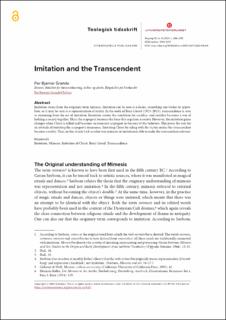Imitation and the Transcendent
Peer reviewed, Journal article
Published version

Åpne
Permanent lenke
https://hdl.handle.net/11250/2978303Utgivelsesdato
2021Metadata
Vis full innførselSamlinger
Originalversjon
Grande, P. B. (2021). Imitation and the transcendent. Teologisk Tidsskrift, 10(4), 204-215. 10.18261/issn.1893-0271-2021-04-04Sammendrag
Imitation stems from the originary term mimesis. Imitation can be seen as a desire, something one wishes to approbate, or it may be seen as a representation of reality. In the work of René Girard (1923–2015), transcendence is seen as stemming from the act of imitation. Imitation creates the condition for sacrifice, and sacrifice becomes a way of holding a society together. Thus, the scapegoat becomes the force that regulates a society. However, the imitation game changes when Christ is killed and becomes an innocent scapegoat in the eyes of the believers. This paves the way for an attitude of imitating the scapegoat’s innocence. Imitating Christ by siding with the victim makes the transcendent become a reality. Thus, in this article I ask in what way mimesis or imitation is able to make the transcendent relevant.
